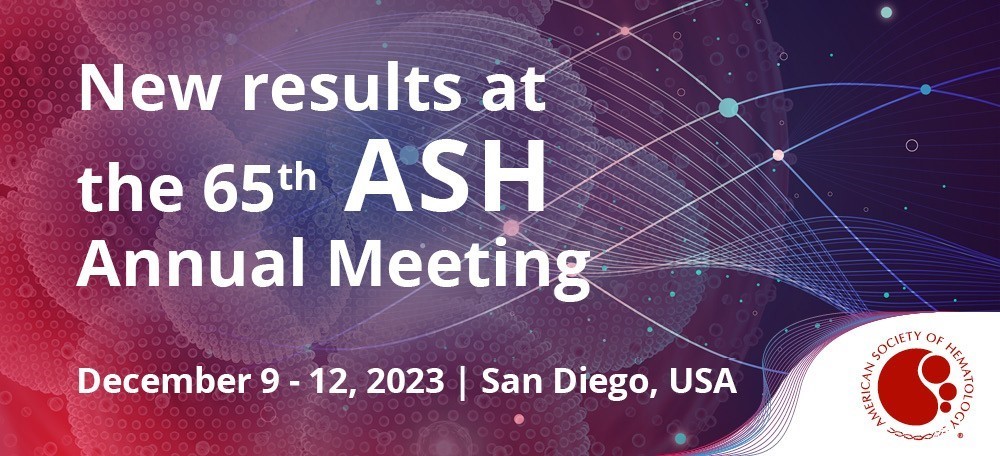During the 65th ASH meeting that took place in San Diego in December 2023, many interesting abstracts concerning immune thrombocytopenia have been presented, covering different topics from the pathogenesis to treatments, from diagnosis to bleeding and thrombotic risk.
Here you can find a summary of the most relevant presentations; for the complete list of the abstracts, please visit the American Society of Hematology official website.
Treatment of primary ITP.
In the last years we have become accustomed to seeing many advances in the treatment of ITP, and the latest ASH meeting did not disappoint us. Besides TPO-mimetics, which are widely used as second-line therapy, advances in other treatment modalities have been highlighted. They include the BTK inhibitor rilzabrutinib, the FcRn inhibitor efgartigimod, an anti-CD38 antibody, a JAK 1/2 kinase inhibitor, and even the preclinical data of an anti-CD19 CAR-T cell and in vitro data of an anti-GPIbα chimeric auto-antibody receptor T cell.
The efficacy and safety of TPO-mimetics when used early in the course of the disease was explored by Virk Z et al., comparing the outcomes of patients treated with avatrombopag before (23) or during chronic phase (55). No differences were observed in terms of efficacy (considering both platelet response and bleeding events) and safety, with special focus on the occurrence of thrombocytosis and thromboembolic events with only one patient in the chronic group who developed a VTE.
TPO-mimetics are widely used as second-line therapy. Kuter D et al. reported on 375 patients with primary ITP lasting ≥3 months who were started with either TPO-RAs (51%) or rituximab (49%). A higher proportion of patients switched from rituximab to TPO-RAs (23.6%) than vice versa (9%). In both groups, the rate of bleeding events was 288 per 1000 person-years, thromboembolic events were 129 and infections 70 per 1000 person-years.
The use of high dose romiplostim (10mcg/kg) in patients with severe bleeding to rapidly increase platelet counts is quite common in clinical practice. However, King E et al. found that this practice significantly increased thrombotic events without affecting platelet response or time to response.
Yin J et al. and Fu H et al. explored the safety and efficacy of the combination of rhTPO plus either hetrombopag or eltrombopag. The first study enrolled 30 patients with severe ITP, mostly newly diagnosed. Platelet response was quick (a median of 4.5 days to reach a platelet count > 30×109/L), and no thrombotic events were reported. Similar results were reported by Fu H et al. with the combination of eltrombopag and rhTPO.
Beyond TPO-mimetics, promising results emerged from trials involving BTK inhibitors and efgartigimod. Cooper N et al. reported the results of part B phase 1/2 study with rilzabrutinib. 26 patients with relapsed/refractory ITP received rilzabrutinib 400 mg bid. The primary endpoint of durable platelet response was achieved by 9 patients (35%). Notably, 25% of patients achieved platelet counts ≥50×109/L by day 15 of treatment. Common AEs included diarrhea, headache and nausea. Tarantino M et al. reported on the effects of rilzabrutinib on bleeding and health-related quality of life (HRQoL).
Broome C et al. highlighted the rapid platelet count increase, within the first 7 days after treatment with efgartigimod in the phase 3 ADVANCE IV study.
New therapeutic approaches include cellular therapy, anti-CD38 antibodies and kinase inhibitors.
Wang Y et al. demonstrated the efficacy of CD19 CAR-T cells in a murine model of ITP, showing a significant increase in platelet count, and a decrease in the percentage of CD19+ B cells, CD138+ plasma cells, and antiplatelet antibodies.
Zhou J et al. developed anti-GPIbα chimeric auto-antibody receptor (CAAR) T cells that identify and eliminate autoreactive B cells, with promising results in vitro.
Chen Y et al. conducted a phase I study to explore the safety and efficacy of umbilical cord-derived mesenchymal stem cells (UC-MSCs) in 18 patients with R/R ITP, reporting a 44.4% response rate, with an acceptable safety profile.
Chen Y et al. reported encouraging results from a phase II trial with CM313, an anti-CD38 antibody administered weekly for 8 weeks: the primary endpoint of a platelet count ≥50×10 9/L within 8 weeks after the first dose was achieved by all seven evaluable patients.
Zhao P et al. evaluated the efficacy of baricitinib, a JAK 1/2 kinase inhibitor, in a randomized phase II trial, as first-line treatment in combination with high-dose dexamethasone, demonstrating a higher sustained response rate at 6 months, compared to dexamethasone alone.

